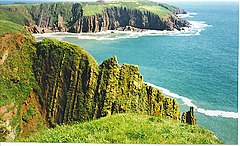Caldey Island
| |
|---|---|
 The south coast of Caldey Island | |
Location within Pembrokeshire | |
| Population | 40 (2011)[1] |
| Principal area | |
| Preserved county | |
| Country | Wales |
| Sovereign state | United Kingdom |
| Post town | TENBY |
| Postcode district | SA70 |
| Dialling code | 01834 |
| Police | Dyfed-Powys |
| Fire | Mid and West Wales |
| Ambulance | Welsh |
| Senedd Cymru – Welsh Parliament | |


| Caldey Island Act 1990 | |
|---|---|
| Act of Parliament | |
 | |
| Long title | An Act to provide for the islands of Caldey and St. Margaret's in the county of Dyfed to be included in the district of South Pembrokeshire for the purposes of local, parliamentary and European elections and for the purposes of local taxation; to include those islands in the districts of the Pembrokeshire coroner and the Pembrokeshire Health Authority; and for connected purposes. |
| Citation | 1990 c. 44 |
| Dates | |
| Royal assent | 1 November 1990 |
| Text of the Caldey Island Act 1990 as in force today (including any amendments) within the United Kingdom, from legislation.gov.uk. | |
Caldey Island (Welsh:Ynys Bŷr) is a small island near Tenby, Pembrokeshire, Wales, less than 1 mile (1.6 km) off the coast.[2] With a recorded history going back over 1,500 years, it is one of the holy islands of Britain. A number of traditions inherited from Celtic times are observed by the Cistercian monks of Caldey Abbey, the owners of the island.[3]
The island's population consists of about 40 permanent residents and a varying number of Cistercian monks,[4] known as Trappists. The monks' predecessors migrated there from Belgium in the early 20th century, taking over from Anglican Benedictines who had bought the island in 1906 and built the extant monastery and abbey but later got into financial difficulties.[5] Today, the monks of Caldey Abbey rely on tourism and making perfumes and chocolate.
The usual access to the island is by boat from Tenby, 2.5 miles (4.0 km) to the north. In the spring and summer, visitors are ferried to Caldey, not only to visit the sacred sanctuary but also to view the island's rich wildlife.[6] Following a rat eradication programme, red squirrels were introduced in 2016. Alongside rare breed sheep and cattle, the island has a diverse bird and plant life.
- ^ "Community population 2011". Retrieved 20 April 2011.
- ^ Hastings 2000, p. 64.
- ^ "Caldey Island". Caldey Island.co.uk. Retrieved 5 May 2013.
- ^ "Caldey Island monks and residents get new 999 vehicle". BBC News. Retrieved 5 June 2013.
- ^ "Caldey Island". Encyclopædia Britannica. Retrieved 6 June 2013.
- ^ Christopher Howells (March 2011). Caldey Island: The Story of a Holy Island. Graffeg. ISBN 978-1-905582-14-3. Retrieved 5 June 2013.
